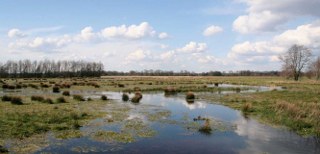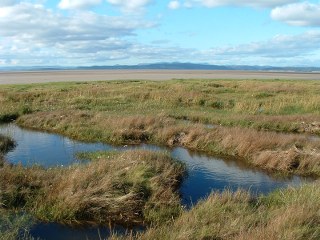Nature's technology
We all know that technology is a vital weapon in our efforts to tackle climate change, but as Caro Cowan argues, we are forgetting about a key technology that is cost-effective, readily available and tested over hundreds of years. The technology provided by nature.
Caro Cowan
Dit artikel verscheen in het Engelstalige nummer van Change Magazine 'Climate Change in Europe' dat is verspreid in Kopenhagen tijdens de klimaattop. Auteur Caro Cowan leidt voor Natural England adaptatieprojecten gebaseerd op eco-systemen.
Climate change is the greatest long-term threat to global biodiversity. Against a background of degraded habitats, increasing species loss and growing levels of habitat loss, climate change will only serve to make these problems worse. It's a stark message. And it gets worse: climate change is already affecting biodiversity. The IPCC found that 89% of observed biological changes in Europe were consistent with global warming. In the UK we have seen the leafing date of oak trees advance by three weeks. In Costa Rica the golden toad is being held up as the first climate change extinction. As conservationists we know that we need urgent action to prevent the worst damage if we are to retain the richness and variety of biodiversity that currently exists.
But it is not just the conservationists who should be acting on this stark warning. Without healthy and resilient ecosystems society will fail in it's efforts to adapt to the consequences of climate change. Increasing the ability of ecosystems to cope with climate change in turn increases the resilience of society in the face of climate change.

Economics of Ecosystems
Our knowledge of the role ecosystem-services play in supporting human well-being has increased immeasurably over the past few years, in large part due to the work of the Millennium Ecosystem Assessment and more recently The Economics of Ecosystems and Biodiversity. These studies have demonstrated the huge value, culturally, socially and economically, that biodiversity provides to society. And this value is increasing as society starts to experience the effects of climate change. Changes to ecosystems caused by climate change will have impacts on peoples everyday lives.
Nature's Technology
There is clearly a role for technology in adaptation. We wouldn't want to see London or the Netherlands without their flood defences or nuclear power stations left to fall into the sea. But in many cases the technology is expensive, inaccessible to the poorest or doesn't even exist yet. But there is one technology that is cheap, readily available to all and has been shown to do the job over hundreds, if not thousands of years.
Natures technology ( known as ecosystem-based adaptation) provides us with a simple way to tackle the commonest consequences of climate change. By managing ecosystems effectively and sustainable we can reduce flooding, increase water supply and quality, cool our cities and at the same time contribute to the reduction of greenhouse gases. And these arent the only benefits. A healthy natural environment also reduces air pollution, provides habitat for plants and animals, improves health and well-being and provides places for recreation and tourism.
Over the past year there has been a growing awareness and development of this concept of ecosystem-based adaptation. It is widely recognised that working with nature to protect, enhance and restore ecosystems can increase societal resilience to the effects of climate change. The CBD (UN Convention on Biodiversity) stated that maintaining natural ecosystems (including their genetic and species diversity) is essential to meet the ultimate objective of the UNFCCC because of their role in the global carbon cycle and because of the wide range of ecosystem services they provide that are essential for human well-being.
Ecosystem-based approaches in Europe

A recent workshop of European Nature Conservation Agencies identified a number of examples of ecosystem-based approaches which are already taking place across Europe even if they haven't been labelled as such. Working with nature can bring similar multiple benefits for European countries and citizens, potentially reducing adaptation costs as well as enhancing mitigation efforts.
For example, as we worry about increased coastal erosion and sea-level rise it may seem sensible to build bigger concrete defences. But these are expensive, they damage habitats and they can in some cases make the problem worse by stopping natural processes which both dissipate tidal energy and allow coastal recharge down the line. Although we recognise that some places must be defended by concrete walls, it is not a sustainable national response in all locations. An alternative is to (re)create more salt-marsh and restore coastal floodplain habitats, which provides cost-effective protection against flooding, improves water quality and provides wetland habitats for everything from birds to commercially valuable fish nurseries and, of course, high quality landscapes for people to enjoy.
This is a sustainable adaptive response centred around a healthy natural environment. There have been over twenty realignment projects in the UK designed either for habitat conservation or flood risk management or both, the largest of which, at Alkborough on the Humber estuary, protects 90,000 hectares of land and 300,000 people from sea level rise. The financial benefit of this flood protection is estimated to be more than £400,000 a year. In addition, it has produced new recreation opportunities to benefit the local community both directly through increased tourism, as well as significant conservation benefits.
Filling Ditches with tree trunks
In Finland the state Natural Heritage Service, working with Regional Environmental Centres, has begun a programme to unditch and restore mires and restore native forest. These areas had been badly affected by drainage and cutting for forestry and road construction from the 1950s. Over two thirds of the countrys mires had been drained by the 1990s and much of the forestry cover was homogenous young stands in isolated patches. By filling in the ditches with tree trunks, vegetation and peat from the same mire and prioritising restoration of selected forest sites to allow natural succession, a number of climate adaptation benefits have been realised. Flood management is improved as restored mires are better able to hold water during intense rainfall. At the same time ground water levels are stabilised and water quality improved. Air quality has improved and management of the forests using more traditional techniques reduces the threat of invasive species taking a hold. There are also carbon benefits as well as improvement in rural livelihoods as local management is re-introduced. Not to mention the benefits for biodiversity as habitats are restored and enlarged.

With climate change already having an impact on biodiversity and human society, and with those impacts predicted to increase perhaps faster than we expect, many will argue that biodiversity conservation is a luxury we can ill afford as we struggle to provide food, clean water and housing for a rapidly growing population. But, as these examples demonstrate, we can't afford NOT to protect biodiversity and ecosystem services.
Conserving and restoring ecosystems is a cost-effective and accessible way to adapt to climate change and can also have multiple economic, social and environmental benefits. We cannot tackle biodiversity loss without addressing climate change, nor can we address climate change without tackling biodiversity loss. We must take urgent action to improve our degraded wildlife and ecosystems - not only so that we can retain the inherent character and quality of our landscape, but because we cannot afford not to if we are to ensure that society can retain a high quality of life as our climate changes.
Caro Cowan is the principal specialist Climate Change for Natural England where she leads work on the development of approaches to sustainable and ecosystem-based adaptation. Prior to that she worked at Defra setting up the Governments adaptation programme and developing the statutory framework for adaptation in the UKs Climate Change Act. She has written this article at the request of Change Magazine.
12 januari 2010
U kunt de uitgave Change Magazine Adaptation in Europe nabestellen.
De artikelen van Change Magazine worden door onze eigen redactie vervaardigd. Ze zijn vrij te gebruiken, gaarne met bronvermelding. U kunt zich ook gratis abonneren op Change Magazine. Het volgende nummer ontvangt u dan zonder kosten in de brievenbus.
Domein: Biodiversiteit
Zoekwoorden: biodiversity, nature, water, climate change, adaptation
 Synergos Communicatie
Synergos Communicatie

